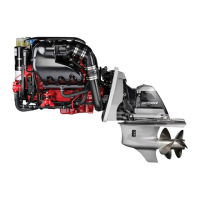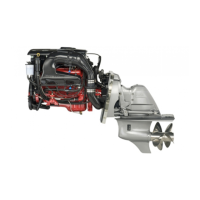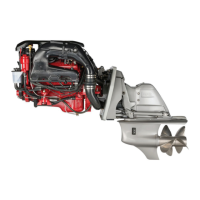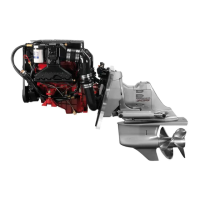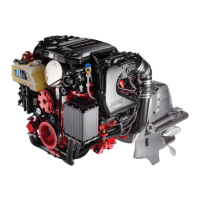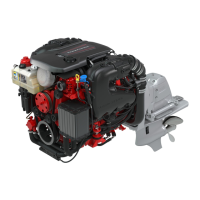Do you have a question about the Volvo Penta V8-300 and is the answer not in the manual?
Explains safety symbols, DANGER, WARNING, CAUTION, NOTICE messages, and their meanings.
Outlines crucial safety measures for boat operation, including reading manuals and using PFDs.
Discusses CO risks, properties, detection, symptoms, and emergency measures.
Covers stationary, underway, and backdrafting operations, detailing safety considerations.
Explains the Electronic Vessel Control system, its components, and integration.
Details ignition lock, e-Key, e-Key remote, ignition switch, and start/stop panel operations.
Covers alarm display, warning indications, and specific fault indicators.
Explains the docking station panel, activation, start/stop, and contrast/backlighting buttons.
Details power trim control, panel functions, and instruments for angle indication.
Explains the autopilot's function, operation, and basic settings.
Lists essential pre-start checks and recommended onboard tools and parts.
Step-by-step guide for pre-start checks, including battery, bilge blower, and fuel valve.
Covers starting procedures using keys, e-Key, and start/stop panels.
Explains engine alarms and safety precautions for boat maneuvering.
Guides on proper shifting procedures, speed control, and system verification.
Explains operating trim controls, trim ranges (Trim, Beach, Tilt), and determining proper trim.
Provides detailed instructions and diagrams for maneuvering with the joystick.
Describes how to stop the engine using start/stop panels or the e-Key.
Step-by-step guide for flushing the engine with fresh water to prolong component life.
Procedure for draining the cooling system to prevent freeze damage.
Explains the EVC diagnostic function, types of alarms, and message pop-ups.
Details Danger, Warning, and Caution pop-ups, their priority, and implications.
Explains the structure of fault code entries, including symptom, EVC action, and operator action.
Lists and describes common faults like battery voltage, trim issues, and control lever faults.
Details faults related to engine, EVC system, joystick, and multilink communication.
Covers faults related to shift actuator, steering wheel, coolant temperature, and oil pressure.
Guidance for striking underwater objects or running aground, including impact damage assessment.
Procedures for handling engine submersion and preventing extensive engine damage.
Instructions for jump-starting a drained battery safely and correctly.
Guides for resolving minor engine problems, emphasizing operational fundamentals.
Diagnoses for engine not cranking, cranking but not starting, and fuel system checks.
Troubleshooting for hard starting (cold/hot engines) and post-run starting problems.
Stresses using genuine marine parts and warns against automotive parts to prevent explosions.
Safety warnings for stopping the engine before service and avoiding pressure washing.
Explains safety symbols, DANGER, WARNING, CAUTION, NOTICE messages, and their meanings.
Outlines crucial safety measures for boat operation, including reading manuals and using PFDs.
Discusses CO risks, properties, detection, symptoms, and emergency measures.
Covers stationary, underway, and backdrafting operations, detailing safety considerations.
Explains the Electronic Vessel Control system, its components, and integration.
Details ignition lock, e-Key, e-Key remote, ignition switch, and start/stop panel operations.
Covers alarm display, warning indications, and specific fault indicators.
Explains the docking station panel, activation, start/stop, and contrast/backlighting buttons.
Details power trim control, panel functions, and instruments for angle indication.
Explains the autopilot's function, operation, and basic settings.
Lists essential pre-start checks and recommended onboard tools and parts.
Step-by-step guide for pre-start checks, including battery, bilge blower, and fuel valve.
Covers starting procedures using keys, e-Key, and start/stop panels.
Explains engine alarms and safety precautions for boat maneuvering.
Guides on proper shifting procedures, speed control, and system verification.
Explains operating trim controls, trim ranges (Trim, Beach, Tilt), and determining proper trim.
Provides detailed instructions and diagrams for maneuvering with the joystick.
Describes how to stop the engine using start/stop panels or the e-Key.
Step-by-step guide for flushing the engine with fresh water to prolong component life.
Procedure for draining the cooling system to prevent freeze damage.
Explains the EVC diagnostic function, types of alarms, and message pop-ups.
Details Danger, Warning, and Caution pop-ups, their priority, and implications.
Explains the structure of fault code entries, including symptom, EVC action, and operator action.
Lists and describes common faults like battery voltage, trim issues, and control lever faults.
Details faults related to engine, EVC system, joystick, and multilink communication.
Covers faults related to shift actuator, steering wheel, coolant temperature, and oil pressure.
Guidance for striking underwater objects or running aground, including impact damage assessment.
Procedures for handling engine submersion and preventing extensive engine damage.
Instructions for jump-starting a drained battery safely and correctly.
Guides for resolving minor engine problems, emphasizing operational fundamentals.
Diagnoses for engine not cranking, cranking but not starting, and fuel system checks.
Troubleshooting for hard starting (cold/hot engines) and post-run starting problems.
Stresses using genuine marine parts and warns against automotive parts to prevent explosions.
Safety warnings for stopping the engine before service and avoiding pressure washing.
| Engine Type | V8 |
|---|---|
| Displacement | 5.3 L |
| Power Output | 300 hp |
| Fuel Type | Gasoline |
| Fuel System | Multi-Point Fuel Injection |
| Cooling System | Freshwater Cooling |
